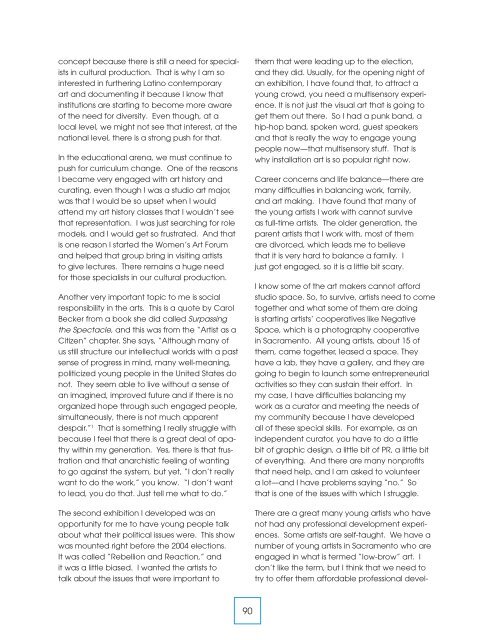The New Face of Arts Leadership in the West - westaf - The Western ...
The New Face of Arts Leadership in the West - westaf - The Western ...
The New Face of Arts Leadership in the West - westaf - The Western ...
Create successful ePaper yourself
Turn your PDF publications into a flip-book with our unique Google optimized e-Paper software.
concept because <strong>the</strong>re is still a need for specialists<br />
<strong>in</strong> cultural production. That is why I am so<br />
<strong>in</strong>terested <strong>in</strong> fur<strong>the</strong>r<strong>in</strong>g Lat<strong>in</strong>o contemporary<br />
art and document<strong>in</strong>g it because I know that<br />
<strong>in</strong>stitutions are start<strong>in</strong>g to become more aware<br />
<strong>of</strong> <strong>the</strong> need for diversity. Even though, at a<br />
local level, we might not see that <strong>in</strong>terest, at <strong>the</strong><br />
national level, <strong>the</strong>re is a strong push for that.<br />
In <strong>the</strong> educational arena, we must cont<strong>in</strong>ue to<br />
push for curriculum change. One <strong>of</strong> <strong>the</strong> reasons<br />
I became very engaged with art history and<br />
curat<strong>in</strong>g, even though I was a studio art major,<br />
was that I would be so upset when I would<br />
attend my art history classes that I wouldn’t see<br />
that representation. I was just search<strong>in</strong>g for role<br />
models, and I would get so frustrated. And that<br />
is one reason I started <strong>the</strong> Women’s Art Forum<br />
and helped that group br<strong>in</strong>g <strong>in</strong> visit<strong>in</strong>g artists<br />
to give lectures. <strong>The</strong>re rema<strong>in</strong>s a huge need<br />
for those specialists <strong>in</strong> our cultural production.<br />
Ano<strong>the</strong>r very important topic to me is social<br />
responsibility <strong>in</strong> <strong>the</strong> arts. This is a quote by Carol<br />
Becker from a book she did called Surpass<strong>in</strong>g<br />
<strong>the</strong> Spectacle, and this was from <strong>the</strong> “Artist as a<br />
Citizen” chapter. She says, “Although many <strong>of</strong><br />
us still structure our <strong>in</strong>tellectual worlds with a past<br />
sense <strong>of</strong> progress <strong>in</strong> m<strong>in</strong>d, many well-mean<strong>in</strong>g,<br />
politicized young people <strong>in</strong> <strong>the</strong> United States do<br />
not. <strong>The</strong>y seem able to live without a sense <strong>of</strong><br />
an imag<strong>in</strong>ed, improved future and if <strong>the</strong>re is no<br />
organized hope through such engaged people,<br />
simultaneously, <strong>the</strong>re is not much apparent<br />
despair.” 1 That is someth<strong>in</strong>g I really struggle with<br />
because I feel that <strong>the</strong>re is a great deal <strong>of</strong> apathy<br />
with<strong>in</strong> my generation. Yes, <strong>the</strong>re is that frustration<br />
and that anarchistic feel<strong>in</strong>g <strong>of</strong> want<strong>in</strong>g<br />
to go aga<strong>in</strong>st <strong>the</strong> system, but yet, “I don’t really<br />
want to do <strong>the</strong> work,” you know. “I don’t want<br />
to lead, you do that. Just tell me what to do.”<br />
<strong>The</strong> second exhibition I developed was an<br />
opportunity for me to have young people talk<br />
about what <strong>the</strong>ir political issues were. This show<br />
was mounted right before <strong>the</strong> 2004 elections.<br />
It was called “Rebellion and Reaction,” and<br />
it was a little biased. I wanted <strong>the</strong> artists to<br />
talk about <strong>the</strong> issues that were important to<br />
<strong>the</strong>m that were lead<strong>in</strong>g up to <strong>the</strong> election,<br />
and <strong>the</strong>y did. Usually, for <strong>the</strong> open<strong>in</strong>g night <strong>of</strong><br />
an exhibition, I have found that, to attract a<br />
young crowd, you need a multisensory experience.<br />
It is not just <strong>the</strong> visual art that is go<strong>in</strong>g to<br />
get <strong>the</strong>m out <strong>the</strong>re. So I had a punk band, a<br />
hip-hop band, spoken word, guest speakers<br />
and that is really <strong>the</strong> way to engage young<br />
people now—that multisensory stuff. That is<br />
why <strong>in</strong>stallation art is so popular right now.<br />
Career concerns and life balance—<strong>the</strong>re are<br />
many difficulties <strong>in</strong> balanc<strong>in</strong>g work, family,<br />
and art mak<strong>in</strong>g. I have found that many <strong>of</strong><br />
<strong>the</strong> young artists I work with cannot survive<br />
as full-time artists. <strong>The</strong> older generation, <strong>the</strong><br />
parent artists that I work with, most <strong>of</strong> <strong>the</strong>m<br />
are divorced, which leads me to believe<br />
that it is very hard to balance a family. I<br />
just got engaged, so it is a little bit scary.<br />
I know some <strong>of</strong> <strong>the</strong> art makers cannot afford<br />
studio space. So, to survive, artists need to come<br />
toge<strong>the</strong>r and what some <strong>of</strong> <strong>the</strong>m are do<strong>in</strong>g<br />
is start<strong>in</strong>g artists’ cooperatives like Negative<br />
Space, which is a photography cooperative<br />
<strong>in</strong> Sacramento. All young artists, about 15 <strong>of</strong><br />
<strong>the</strong>m, came toge<strong>the</strong>r, leased a space. <strong>The</strong>y<br />
have a lab, <strong>the</strong>y have a gallery, and <strong>the</strong>y are<br />
go<strong>in</strong>g to beg<strong>in</strong> to launch some entrepreneurial<br />
activities so <strong>the</strong>y can susta<strong>in</strong> <strong>the</strong>ir effort. In<br />
my case, I have difficulties balanc<strong>in</strong>g my<br />
work as a curator and meet<strong>in</strong>g <strong>the</strong> needs <strong>of</strong><br />
my community because I have developed<br />
all <strong>of</strong> <strong>the</strong>se special skills. For example, as an<br />
<strong>in</strong>dependent curator, you have to do a little<br />
bit <strong>of</strong> graphic design, a little bit <strong>of</strong> PR, a little bit<br />
<strong>of</strong> everyth<strong>in</strong>g. And <strong>the</strong>re are many nonpr<strong>of</strong>its<br />
that need help, and I am asked to volunteer<br />
a lot—and I have problems say<strong>in</strong>g “no.” So<br />
that is one <strong>of</strong> <strong>the</strong> issues with which I struggle.<br />
<strong>The</strong>re are a great many young artists who have<br />
not had any pr<strong>of</strong>essional development experiences.<br />
Some artists are self-taught. We have a<br />
number <strong>of</strong> young artists <strong>in</strong> Sacramento who are<br />
engaged <strong>in</strong> what is termed “low-brow” art. I<br />
don’t like <strong>the</strong> term, but I th<strong>in</strong>k that we need to<br />
try to <strong>of</strong>fer <strong>the</strong>m affordable pr<strong>of</strong>essional devel-<br />
90


